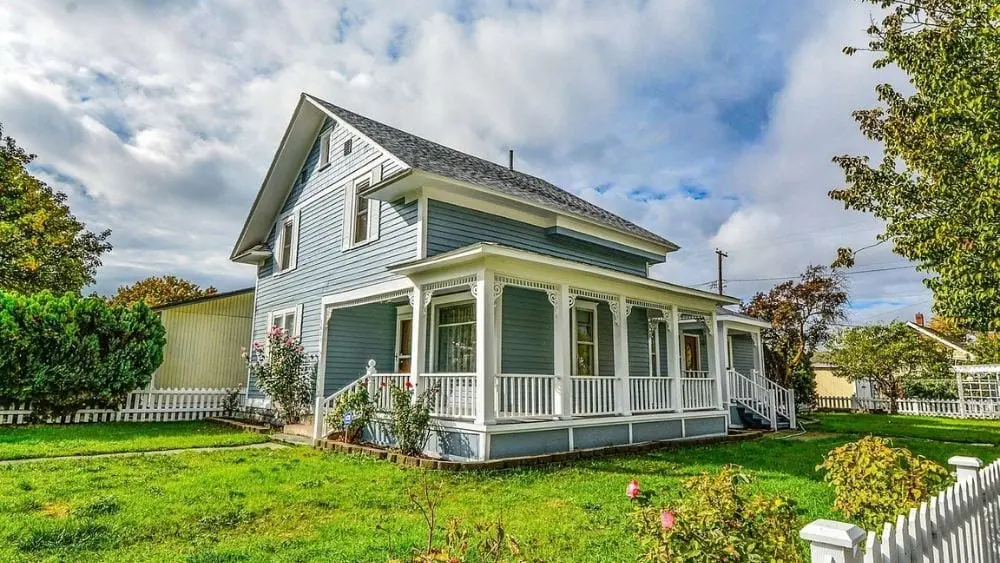
Front porches are popular. Really popular! Of all new single-family homes started in 2017, 69 percent were built with front porches, as opposed to simple front entry. In addition, 24 percent of new homes featured a side or rear porch and 10 percent had a screened-in porch.
Those somewhat surprising figures are taken from the 2018 Annual Builder Practices Survey (based on 2017 data) conducted by the Maryland-based Home Innovation Research Labs (HIRL), a subsidiary of the National Association of Home Builders.
The share of new homes with front porches has remained quite stable over the past 10 years, ranging from a low of 64 percent in 2016 to a high of 72 percent in both 2008 and 2012. Ditto for screened porches. But the number of homes built with a side or rear porch has increased dramatically, rising from the 7 to 10 percent range over the long term to 24 percent in each of the past two years.
Why the increase in side and rear porches? “It’s a way to increase living space,” says Ed Hudson, director of Market Research at the HIRL. “It’s a desire of consumers to add on space with a roof over it for entertainment. They want space that’s useable in all weather and they want to have that space in the privacy of the side or rear of the home. So, open patios are losing a little ground to outdoor areas with roofs.”
Front Porches Top the List
Still, homes with front porches lead the popularity parade over side, rear or screened-in porches by a wide margin.
Hudson notes, however, that the percentage of new homes with front porches “varies widely by region of the country, with New England at 54 percent; Mid-Atlantic, 58 percent; South Atlantic, 71 percent; East North Central, 68 percent; East South Central, 76 percent; West North Central, 67 percent; West South Central, 69 percent; Mountain states, 73 percent; and Pacific, 65 percent.
“As might be expected,” he adds, “the figure is highest in the deep south of Mississippi, Alabama, Tennessee and Kentucky.”
The builder practices survey also shows that front porches on 2017 new homes averaged 98 square feet. Side and rear porches averaged 131 square feet and screened-in porches averaged 196 square feet.
Measured by square footage, the material most commonly used for front porch surfaces was poured concrete (53 percent). This was followed by treated wood (14 percent), composite material (11 percent), brick pavers and natural stone (each at 5 percent), cedar (4 percent) and redwood tiles or plastic/PVC (each at 2 percent).
Adding a Porch to Your New Home
You can work with your home builder to include a front porch (or side or rear porch) in the design and initial construction of your home. Or you can hire a professional contractor to add a porch later. Or if you’re particularly handy, you can even make it a do-it-yourself project. Regardless, you’ll want to know how a porch goes together and what to look for during the construction process.
Here is a common and highly recommended system for building a front porch via the post, beam and joist system.
Pour concrete footing on top of a gravel base where each outside porch post will go. In cold climates, this must be below the frost line. Then, pour a concrete pier on top of the footing that extends a bit past the top of the soil. Fiberboard concrete forms (hollow tubes) for the below-grade piers are readily available. Before the concrete sets, embed an adjustable metal anchor to cradle the porch post and keep the post end raised a bit and away from ground moisture. Obviously, each pier should be at the same height.
For a front porch on a slab foundation (i.e., not raised), surround the base with concrete blocks or removable wood forms, fill the area with gravel and compact it to four inches from the top, then have concrete poured on top.
To support and stabilize the porch on the house side, attach a horizontal ledger board to the home’s framing. The surface of the finished porch must be lower than your home’s interior floor. Use half-inch carriage bolts (add washers on the outside for drainage) that go deeper than the siding and sheathing. Local codes will spell out the required spacing. In some areas, codes require that ledger boards also be supported by posts and footings. It’s a good practice to add flashing where the ledger board meets the house.
A main beam (header joist) is then run along the foundation posts at the perimeter of the porch, and beams (rim joists) are also installed back to the house on each side. Additional beams (double 2-by-8s or 2-by-10s) as needed are run perpendicular from the ledger board to the header joist. Floor joists are then run horizontally between or on top of these beams. It’s important that the porch floor slope slightly away from the house to shed rain water. If there is a crawl space below the porch, add a moisture membrane and air vents, plus skirting to keep animals out.
If the porch is very deep, additional horizontal beams may be needed. Allowable joist and beam spacing is complex and code driven. The American Wood Council offers a free maximum span calculator for wood joists and rafters.
Porch flooring is then laid perpendicular to the home (decks usually have flooring running parallel to the house).
Add paint or stain and voilà, you have a porch.
But Wait, There’s More
Obviously, this brief summary does not cover a variety of possible porch subjects. What architectural style would you like for the porch and what style best fits your home? What about porch stairs and porch railings? How should the porch decking and trim be finished, stained, painted or treated? What are the maintenance requirements? Do you want it screened in? Do you want to add electrical outlets or other amenities, such as a ceiling fan? Finally, what about the currently highly desired porch roof? And, don’t forget the porch swing.
It also leaves out a myriad of details, best practices and construction techniques to make a deck solid, safe and long lasting.
The bottom line: Unless you’re a really accomplished do-it-yourselfer, have the time, and are willing to do a ton of research, the actual nitty-gritty of porch construction is best left to the professional contractor.

Roy Diez is a freelance writer and marketing professional specializing in the architectural, building and construction industry. He is a former editor-in-chief of Professional Builder magazine.
 How to Add Shabby Chic Design in Your New Home
How to Add Shabby Chic Design in Your New Home